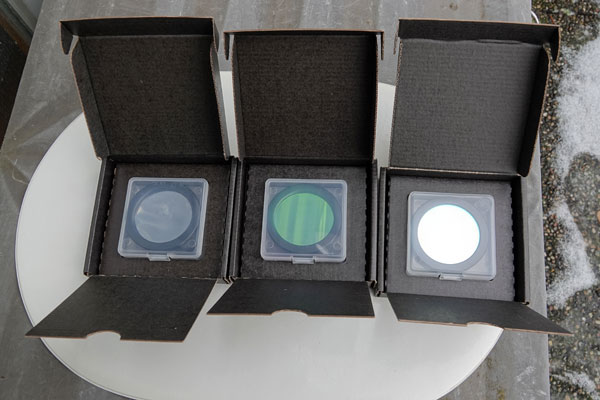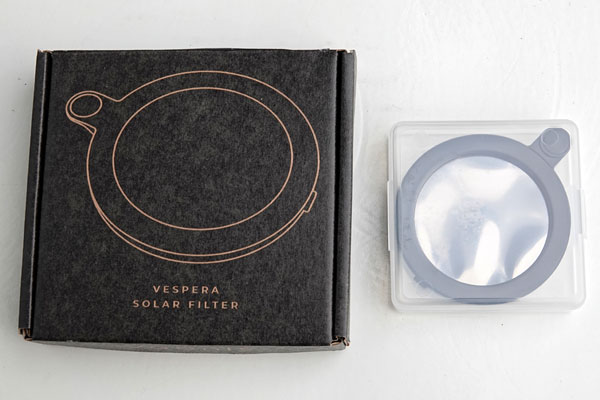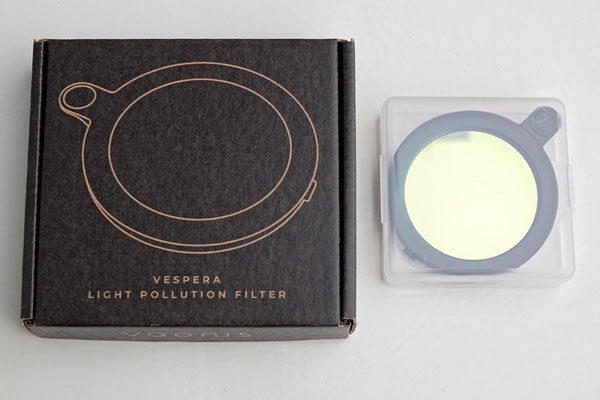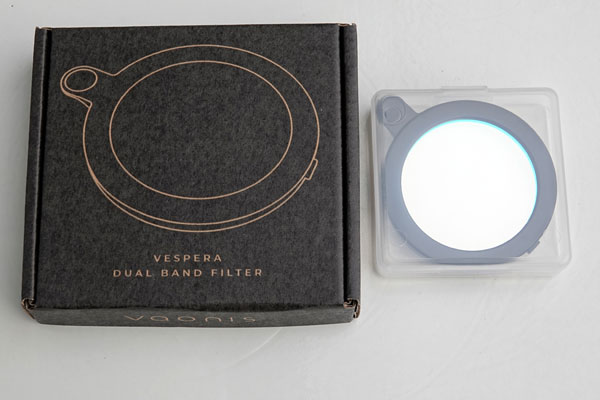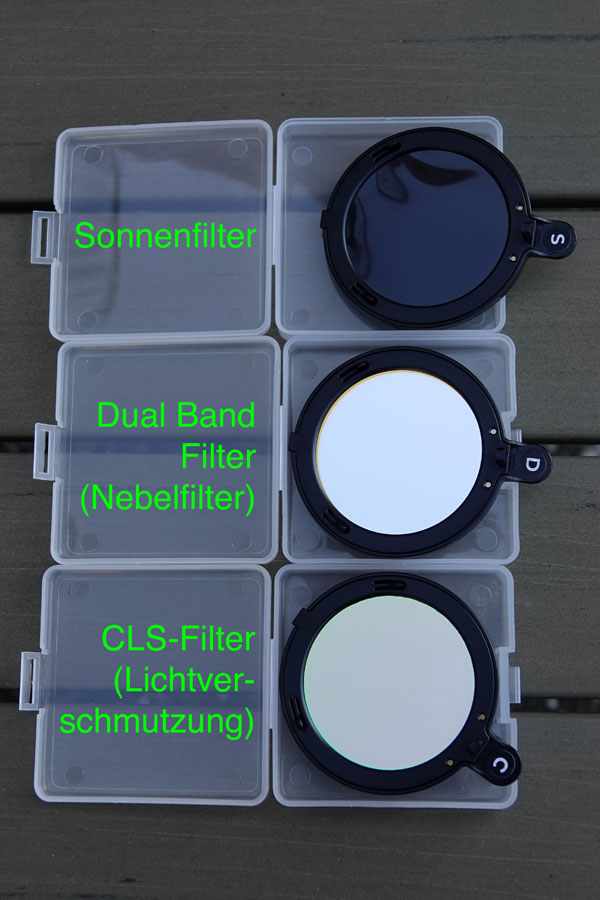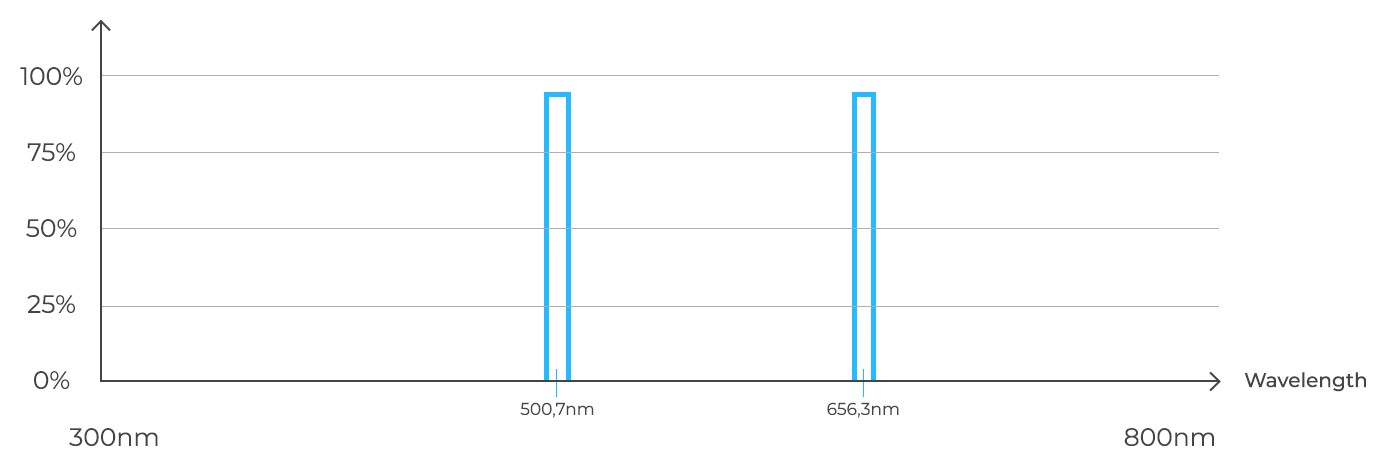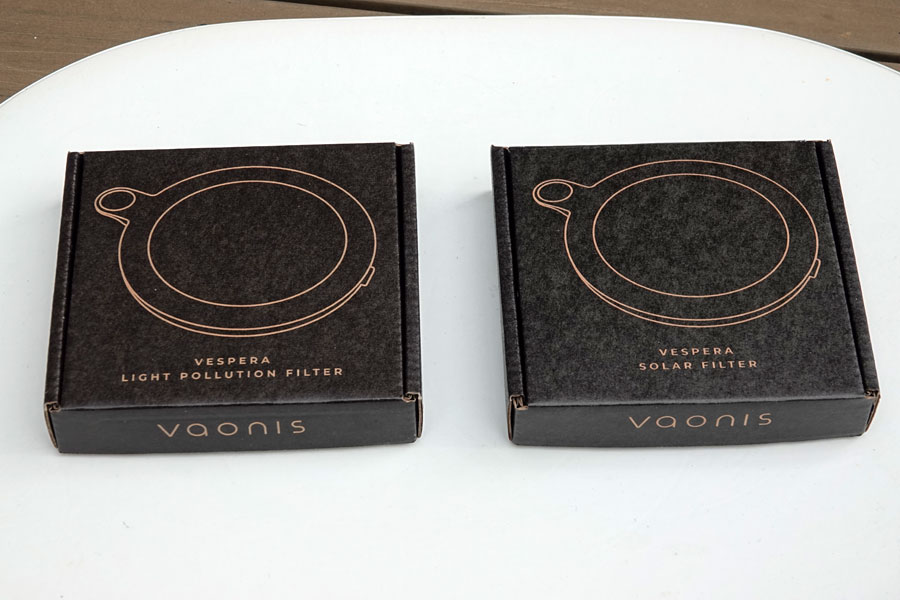Vaonis Vespera - Observations with Filters
Introduction | First Experiences with the Filters | First Conclusions | Links || Appendix: Light Pollution and Solar Filter
Archive
On this page, I describe my first experiences with my electronic 2" refractor telescope Vaonis Vespera 50 mm/200 mm (f/4) when observing with filters. Here, I describe the Light Pollution Filter (or CLS Filter) and the Dual Band Filter. The solar filter and its use is covered on a separate page.
See also pages:
- Vaonis Vespera - Information
- Vaonis Vespera - FAQ
- Vaonis Vespera - Adventurer Pack and More Accessories
- Vaonis Vespera - Observations of the Sun
- Vaonis Vespera - Observations with Filters
- Vaonis Vespera - Further Observations with the Dual Band Filter
- Vaonis Vespera - Dual Band Filter Photos and Topaz Denoise AI
- Vaonis Vespera - Further Observations with the CLS Filter
Note: In June 2024, I sold my Vaonis Vespera smart telescope. I therefore cannot report any further experiences with it here. |
Introduction
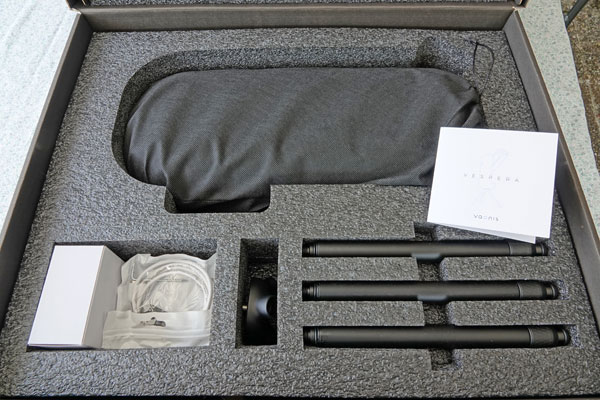 |
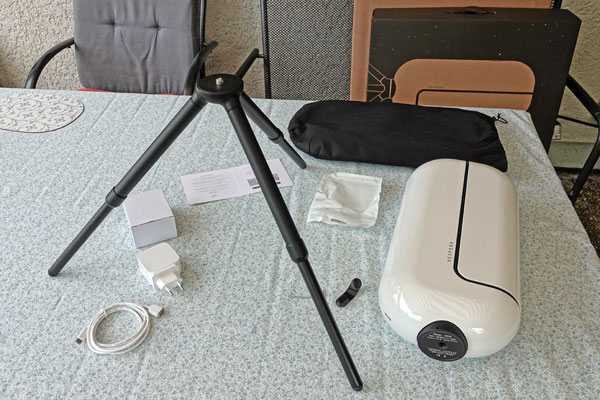 |
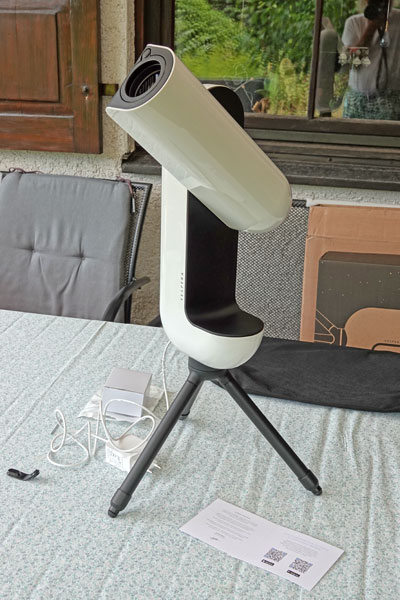 |
Photos: My Vaonis Vespera (end of July 2022)
For the Vaonis Vespera, three filters are available:
- The Vespera Solar Filter,
- the Vespera Light Pollution Filter (CLS Filter),
- the Vespera Dual Band Filter
These filters are "full aperture" filters that are placed in front of the front lens; they are automatically recognized by the Vespera (and the software reacts accordingly to the filter used).
Photos
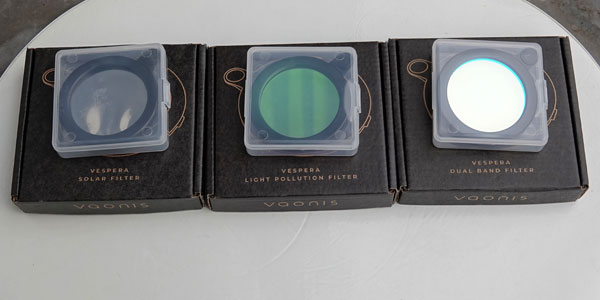 |
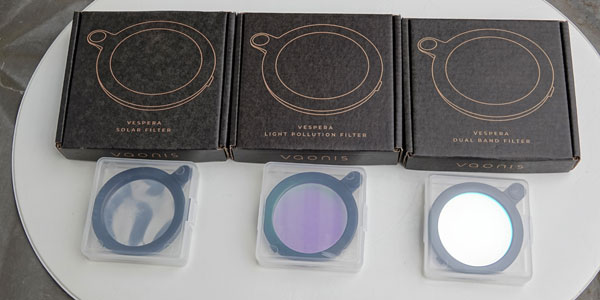 |
|||
The filters, outer boxes opened |
The filters... |
ditto... |
||
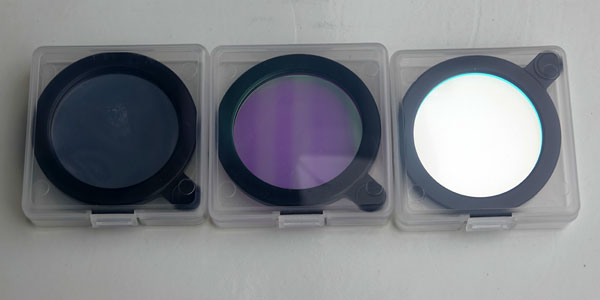 |
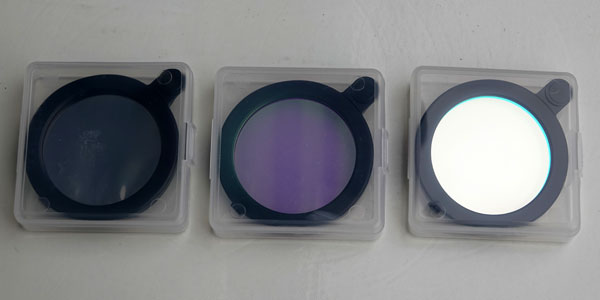 |
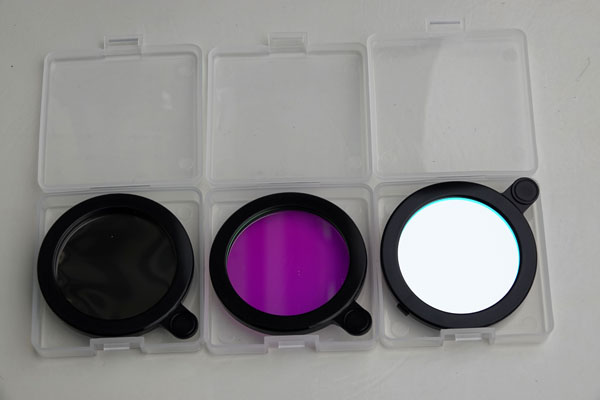 |
||
Ditto... |
Ditto... |
Ditto, boxes opened |
Photos: The filters (left: Solar Filter, center: Light Pollution Filter, right: Dual Band Filter
Solar Filter |
Light Pollution Filter |
Dual Band Filter |
||
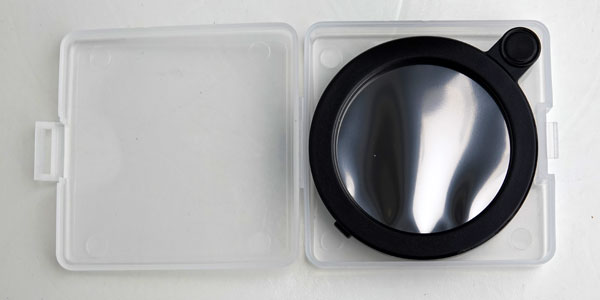 |
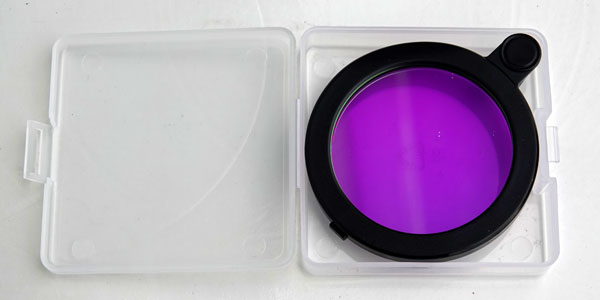 |
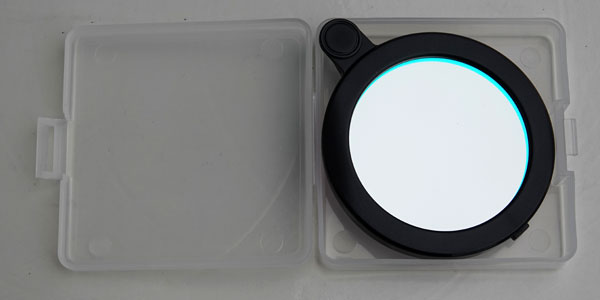 |
||
Solar Filter |
Light Pollution Filter |
Dual Band Filter |
Photos: The filters and their boxes
Photo: The backsides of the filters show the letters S, D, and C that help you distinguish between the filters
Note: The solar filter is covered on a separate page; it has a letter "S" on the "grip".
The Filters
Light Pollution Filter
 |
||
Light Pollution Filter |
Light Pollution Filter |
Description (from Vaonis):
The Vespera Light Pollution Filter or CLS (City Light Suppression) filter allows you to improve the quality of your photos when observing in the city or suburbs. It attenuates the effects of light pollution and thus increases the contrast between the celestial object being photographed and the background sky. It has a letter "C" at the "grip".
The broadband filter blocks wavelengths mainly emitted by urban night lighting or undesirable natural light, while allowing the main wavelengths from celestial objects.
- Essential for observing from an environment where light pollution is very present (urban and peri-urban environment, residential lighting, etc.)
- Improves the quality of nebula photography.
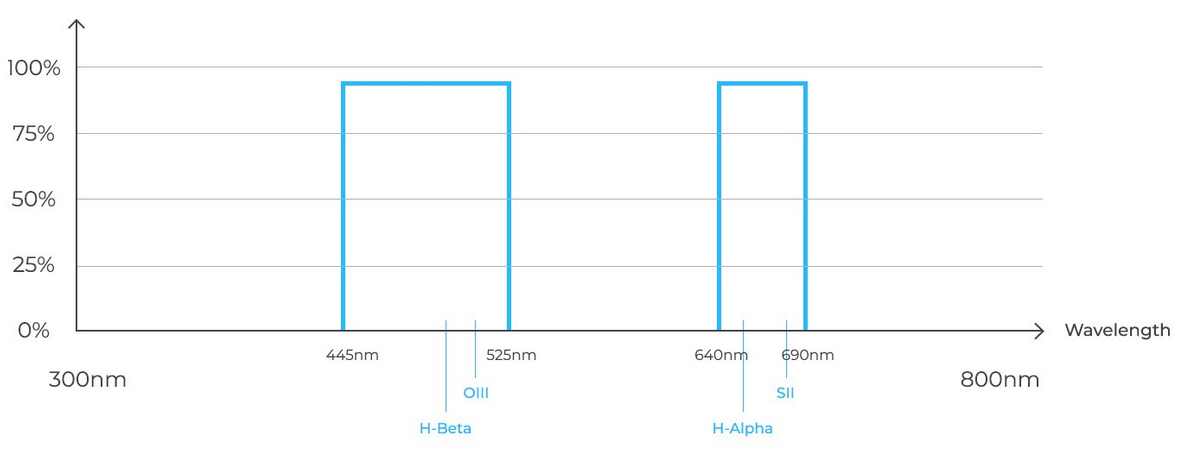
Diagram: Behavior of the Light Pollution Filter (from Vaonis Website, permission granted)
For more information see the respective page on the Vaonis Website.
Dual Band Filter
 |
||
Dual Band Filter |
Dual Band Filter |
Description (from Vaonis):
The Vespera Dual Band Filter is a dual narrowband interference filter that will significantly improve your photo quality whether you are viewing from an urban or natural environment. It has a letter "D" at the grip.
By selecting very precisely the wavelengths of Hydrogen Alpha (H-alpha) and Oxygen III (O-III) (bandwidth 12 nm), found mainly in nebulae, the filter will increase the contrast between the stellar object and the sky background. Thus, its use makes it possible to obtain a higher-quality image, with sharper stars and finer details.
The filter features 12 nm of bandwidth in each wavelength (O-III = 500.7 nm, H-alpha = 656.3 nm).
Diagramm: Behavior of the Dual Band Filter (from Vaonis Website, permission granted)
Vaonis recommends the filter as follows:
- Due to the filtered wavelengths, it is particularly effective for photographing nebulae in emission (e.g.: Orion nebula M42, Heart nebula IC 1805 …), dark nebulae endowed with hydrogen (e.g.: Horsehead or Elephant’s Trunk nebula…), planetary nebulae (e.g.: Owl nebula M97, Dumbbell nebula M27…), supernova remnants (e.g.: Veil nebula, Crab Nebula M1…).
- For globular clusters (e.g.: Hercules cluster M13, cluster M92…), the selectivity of the Dual Band filter will help you to obtain sharper stars.
For more information see the respective page on the Vaonis Website.
First Experiences with the Filters
All in all, both filters have two bandpasses, but the Dual Band Filter's bands are much narrower than those of the Light Pollution Filter. To what extent both filters extend the exposure time, I cannot say at the moment. I did not find a significant effect for the Dual Band Filter. For the Light Pollution Filter, the effect should be even weaker.
Light Pollution Filter (CLS Filter)
I was able to try out the CLS Filter for the first time on April 3, 2023 and compare it with the Dual Band Filter. I was less concerned with light pollution (there are hardly any sodium vapour lamps in my area), but rather with the fact that, according to Vaonis, this filter is supposed to improve the quality of nebula photos in general. The question is whether it really does that and what the difference to the Dual Band Filter is (see below for the latter).
NGC 2244 and Rosette Nebula
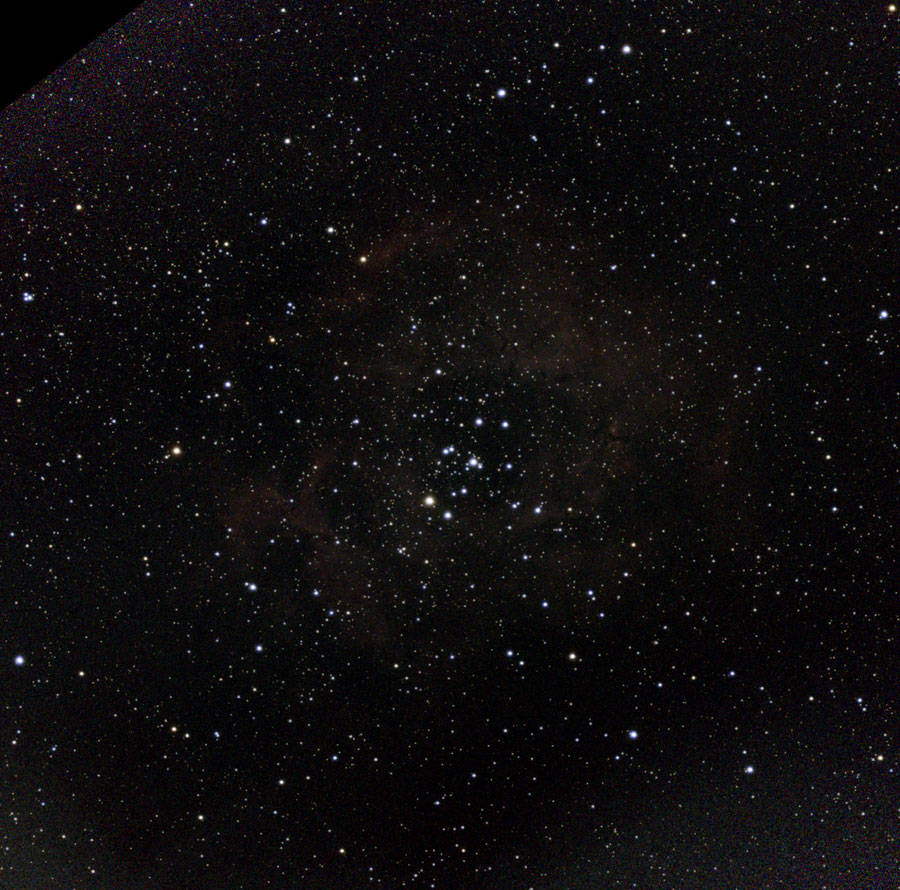 |
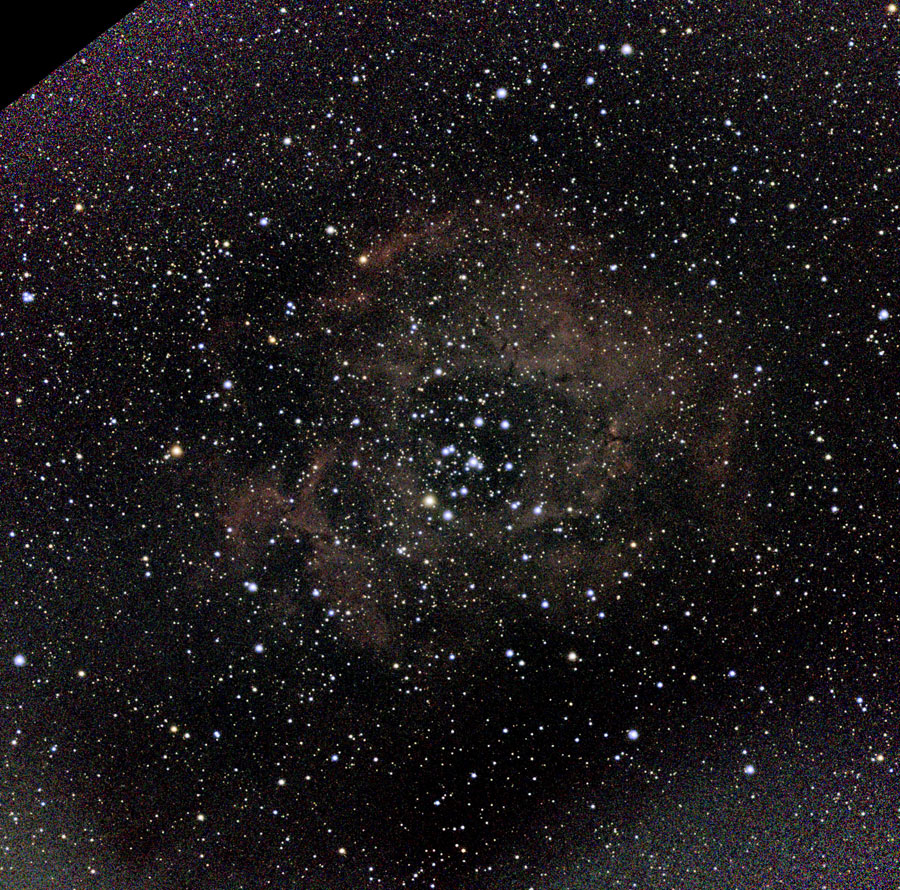 |
|
NGC 2244 + Rosette Nebula, Apr 3, 2023 - original, mosaic, 1490s |
NGC 2244 + Rosette Nebula, Apr 3, 2023 - large, photo left processed |
|
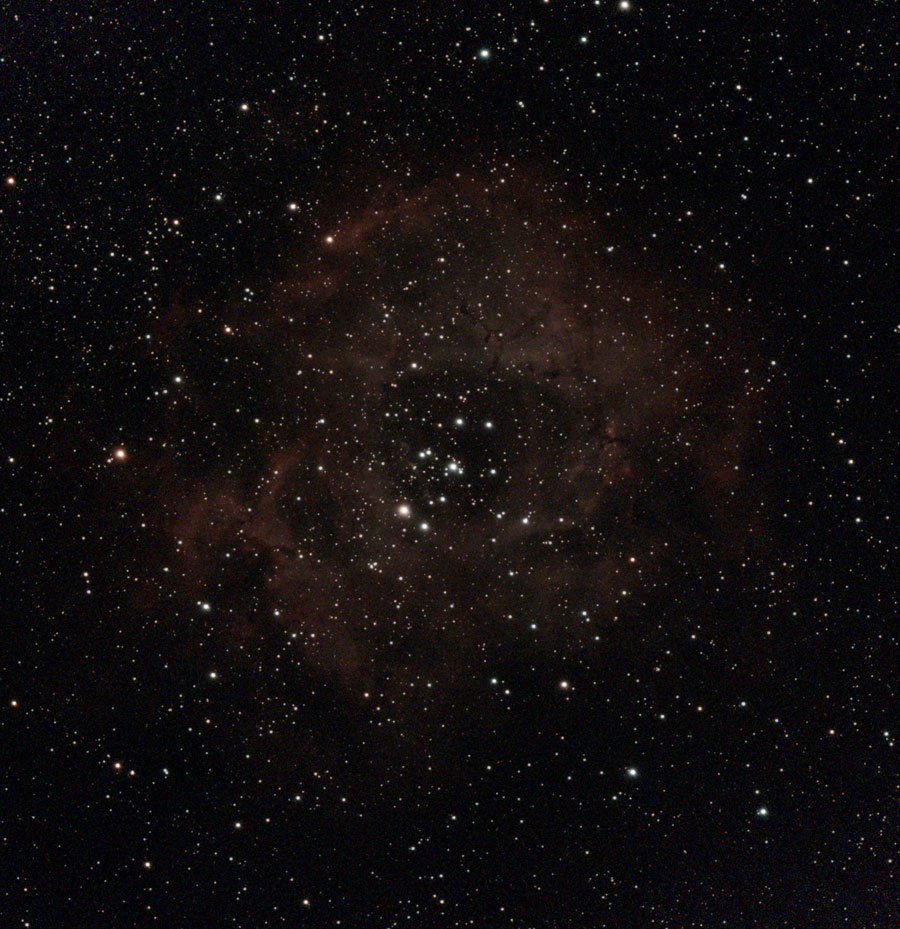 |
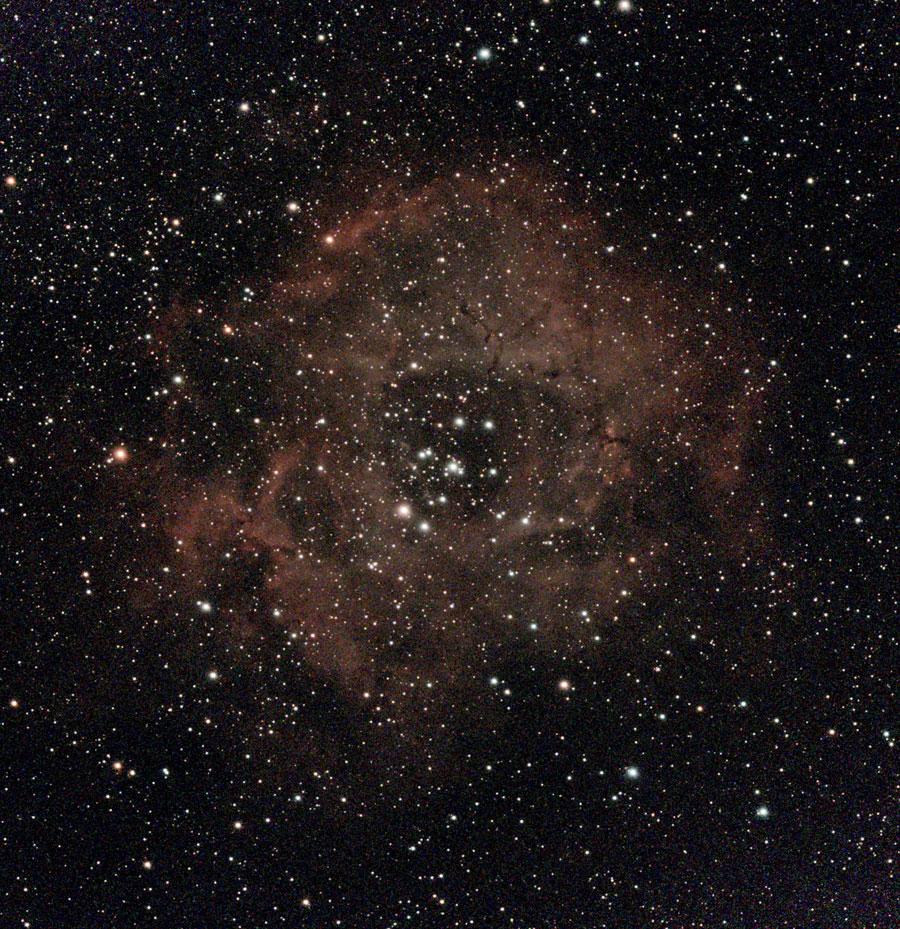 |
|
NGC 2244 + Rosette Nebula, Apr 3, 2023 - original, mosaic, CLS Filter, 1850s |
NGC 2244 + Rosette Nebula, Apr 3, 2023 - large, photo left processed |
Conclusion: The stars are hardly or not at all affected by the CLS filter; however, the nebula comes out more clearly with the filter.
NGC 2174 (Monkey Head Nebula)
On April 5, 2023 I tried out the CLS Filter for the second time, namely on the Monkey Head Nebula NGC 2174 (normal photo).
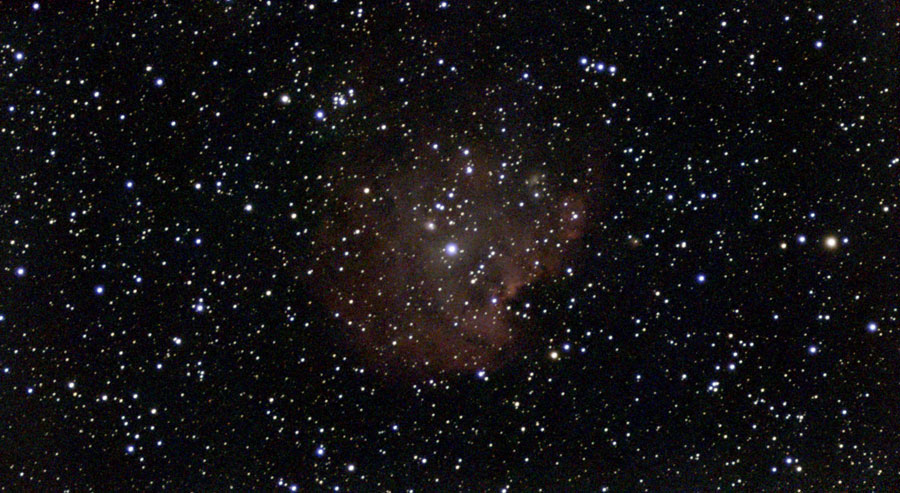 |
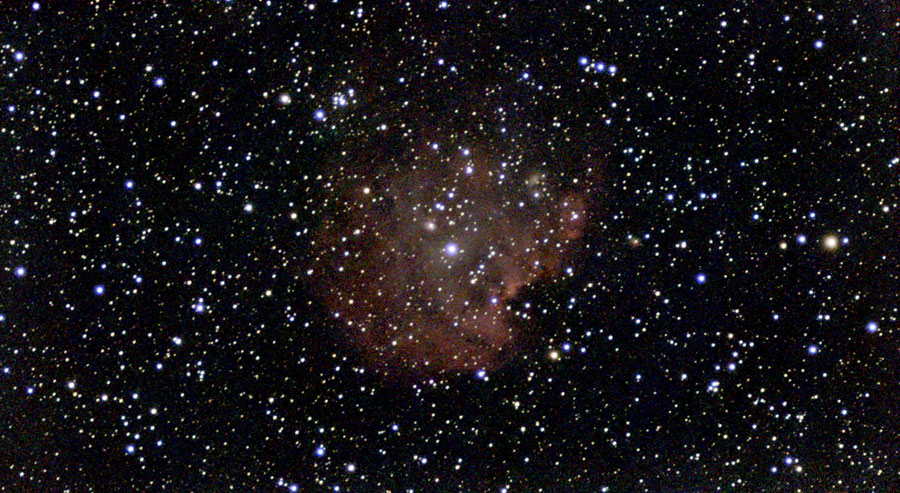 |
|
NGC 2174, Apr 5, 2023 - Original, 35min |
NGC 2174, Apr 5, 2023 - large, photo left processed |
|
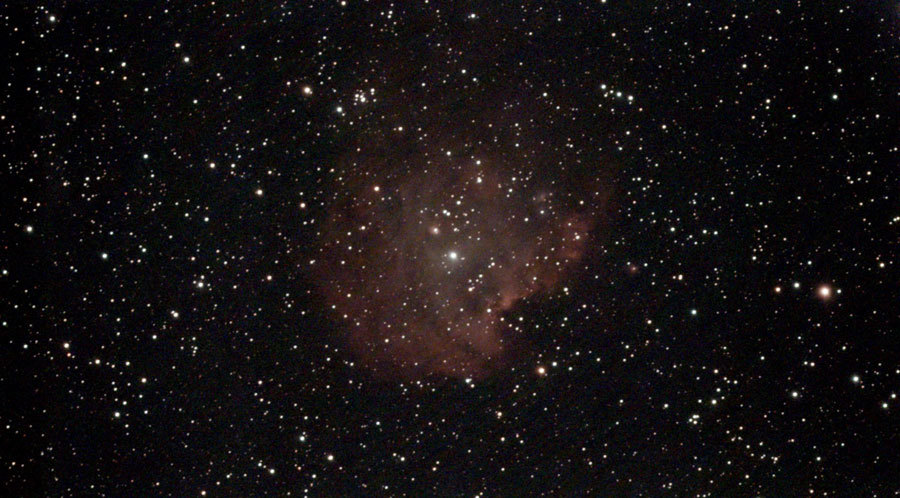 |
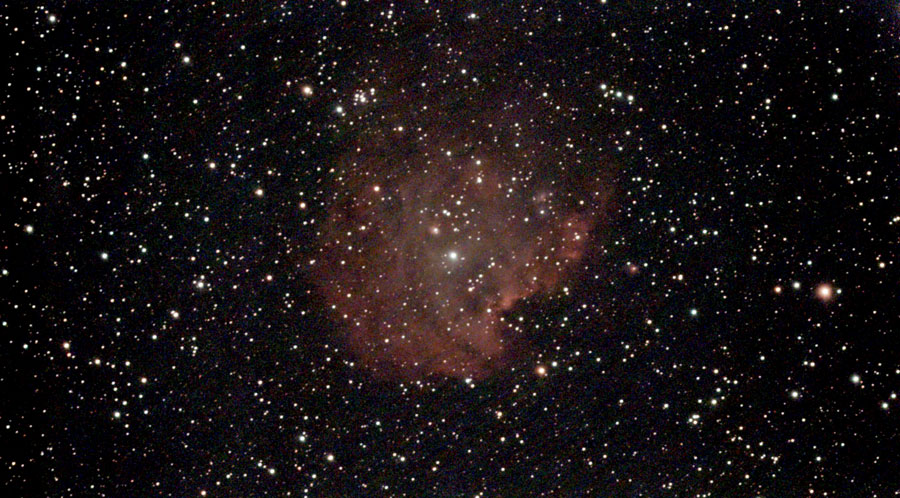 |
|
NGC 2174, Apr 5, 2023 - original, CLS Filter, 35min |
NGC 2174, Apr 5, 2023 - large, photo left processed |
Conclusion: The stars are hardly or not at all affected by the CLS filter; however, the nebula comes out more clearly with the filter.
Dual Band Filter
On February 20, 2023, I was able to try out the Dual Band Filter for the first time. I chose M 42/43 and IC 1805 (Heart Nebula) as sky objects, which are explicitly mentioned by Vaonis as cases where a dual band filter is helpful. I also tried out NGC 2359 (Thor's Helmet). According to Stoyan, this nebula is considered a prime example for the use of nebula filters.
Below, I present photos of M 42/43, NGC 2359 (Thor's Helmet), and IC 1805 (Heart Nebula) taken without and with nebula filter. On April 3, 2023, I tested the filter for a second time with NGC 2244, and on April 5, 2023 for a third time.
M 42/43
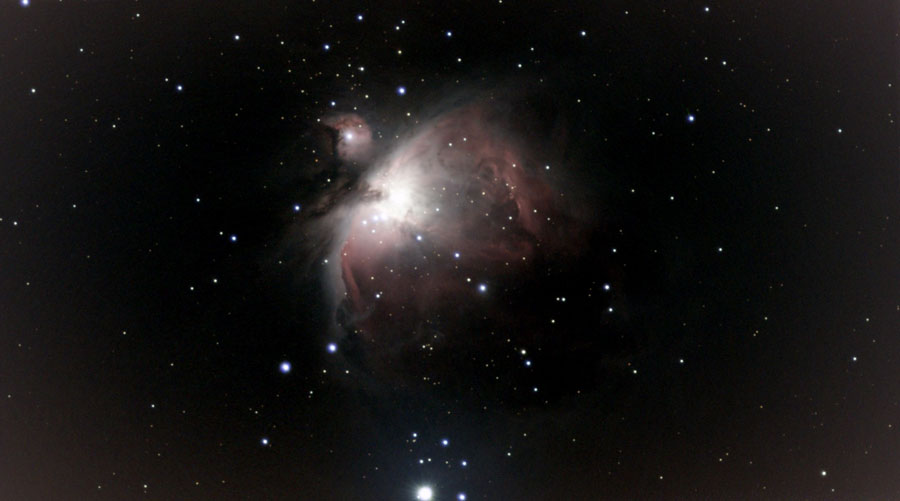 |
 |
|
M 42/43, Jan 18, 2023 - original, 640s |
M 42/43, Jan 18, 2023 - large, photo left processed |
|
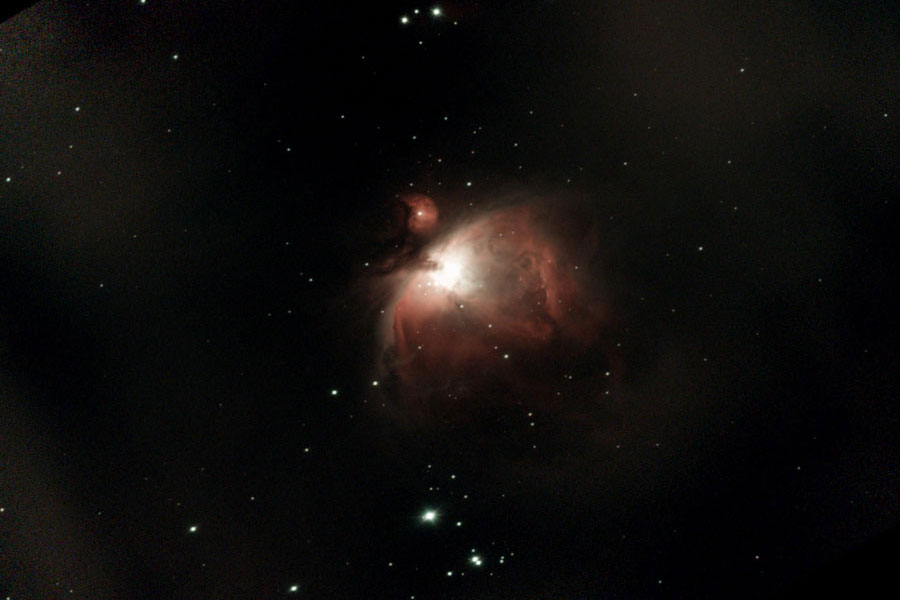 |
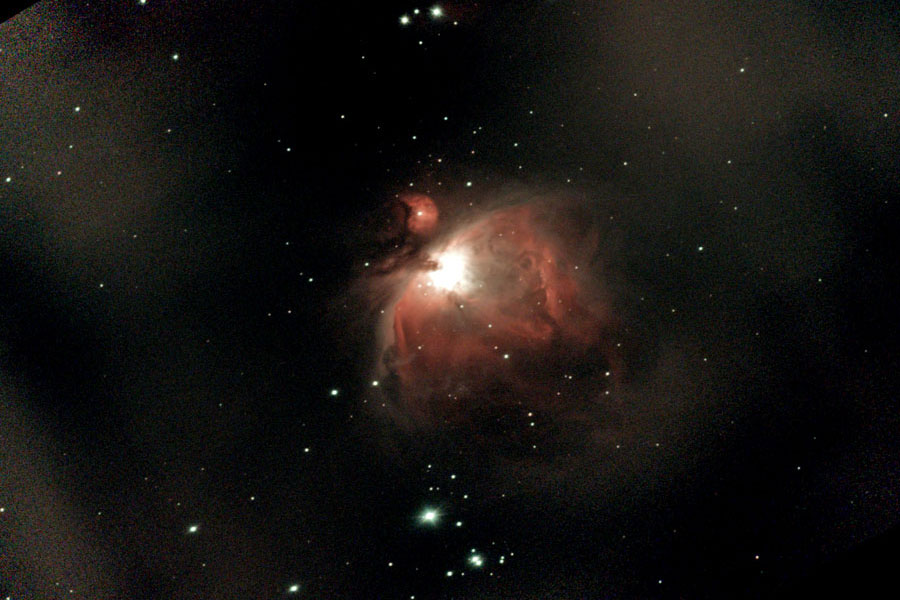 |
|
M 42/43, Feb 20, 2023 - original, 690s, mosaic, Dual Band Filter, image section |
M 42/43, Feb 20, 2023 - large, photo left processed, image section |
M 42/43 (Orion Nebula), NGC 1977 (Running Man Nebula), and NGC 1980 (Lost Jewel of Orion) (Orion)
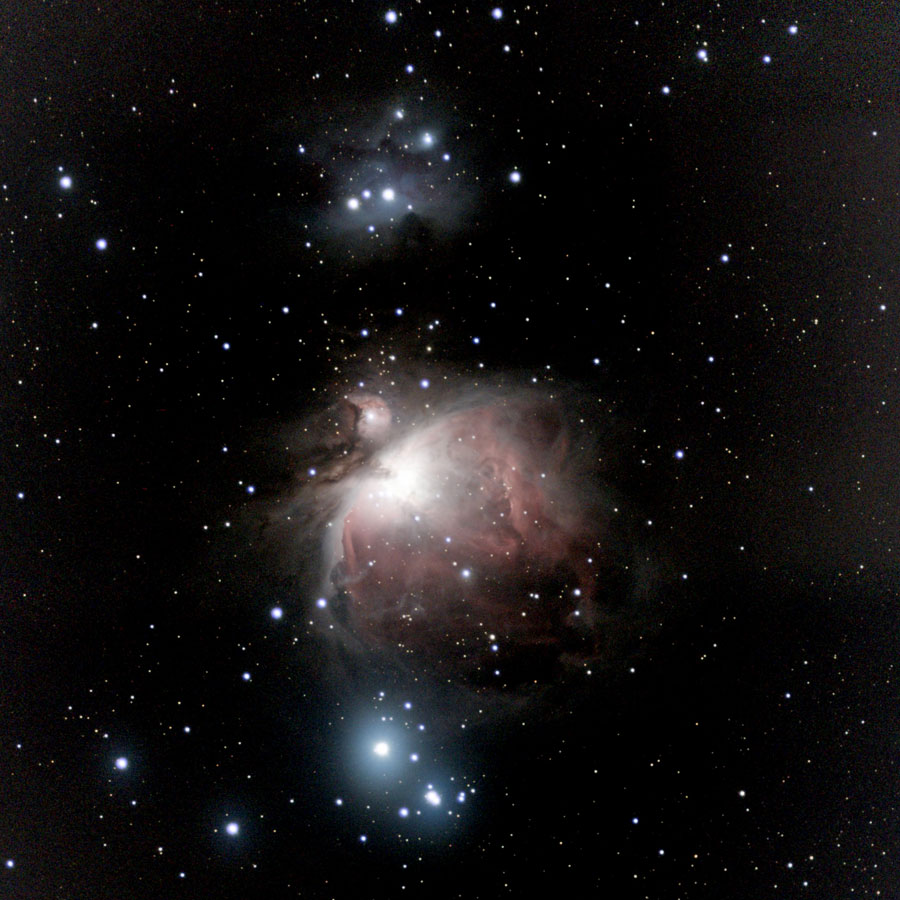 |
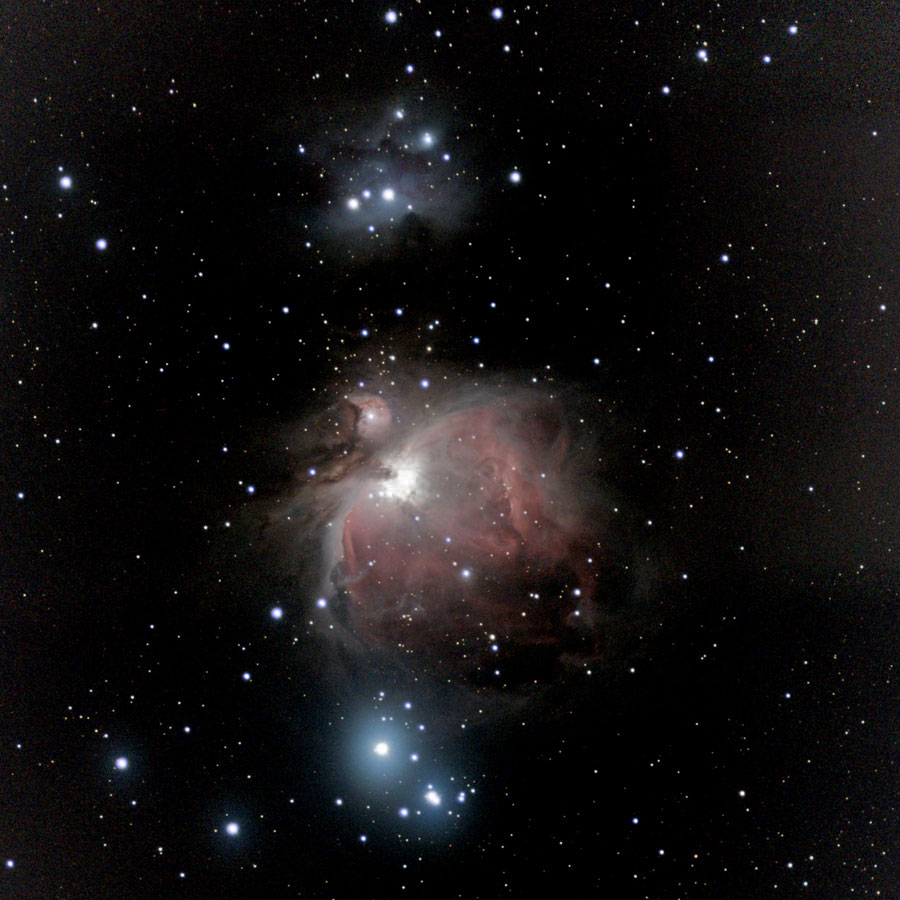 |
|
M 42/43 with NGC 1977 and NGC 1980, Jan 18, 2023 - large (241 frames = 2410 s), mosaic, processed, square section |
Ditto, lights made 100% darker |
|
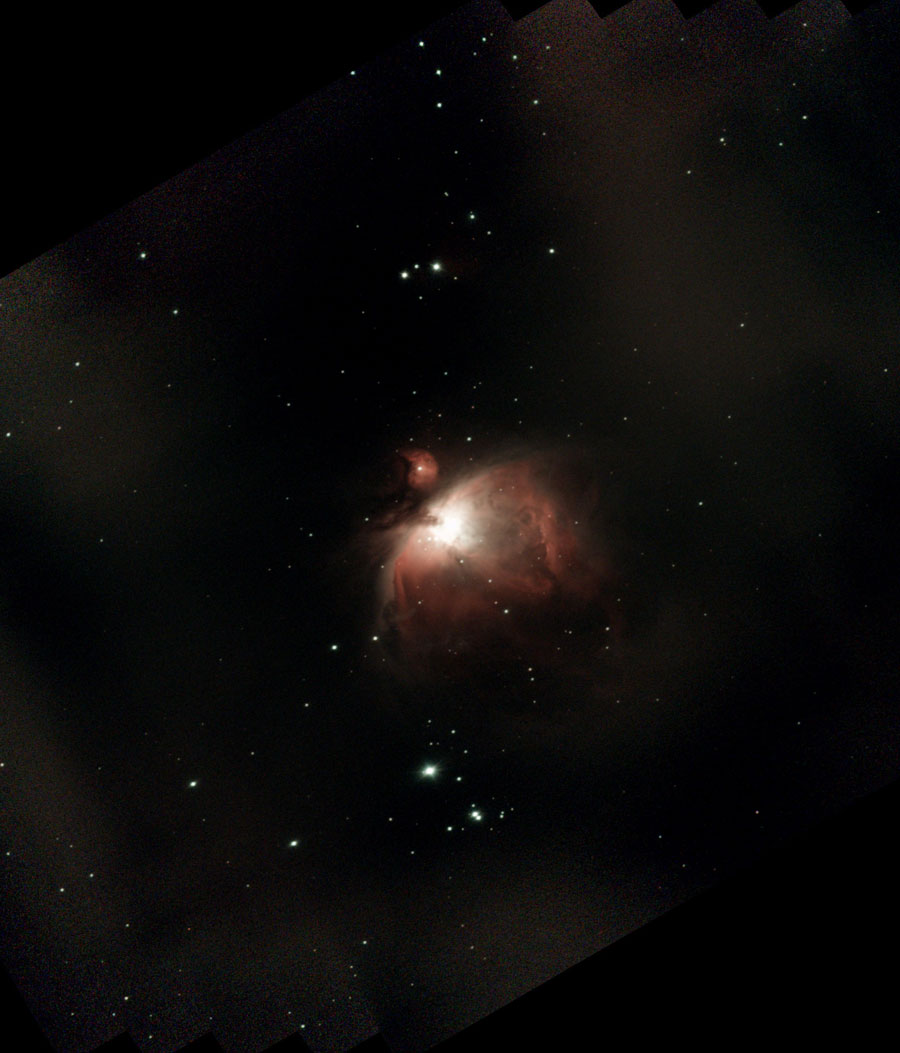 |
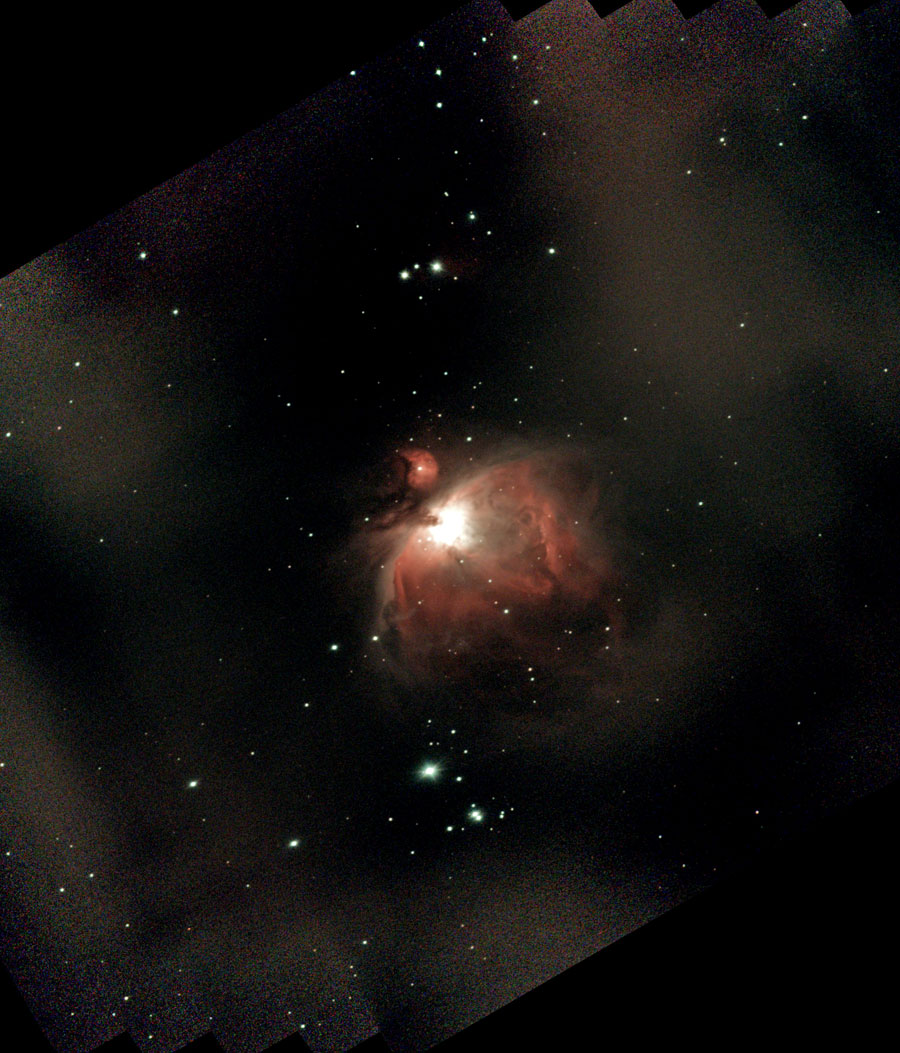 |
|
M 42/43, Feb 20, 2023 - original, 690s, mosaic, Dual Band Filter |
M 42/43, Feb 20, 2023 - large, photo left processed, image section |
The most important first: The dark nebula NGC 1977 has disappeared when using the filter! M 42/43 mainly shows a color difference; the stars are slightly less pronounced with nebula filter than without one.
NGC 2359 (Thor's Helmet)
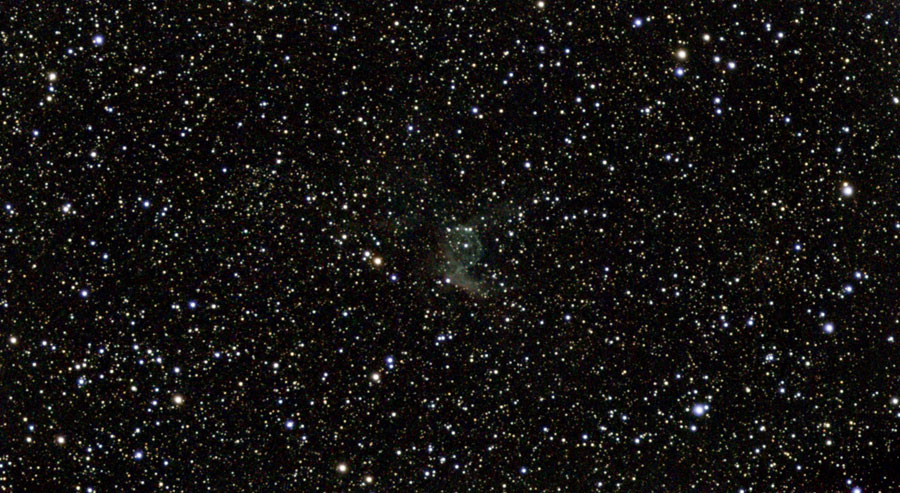 |
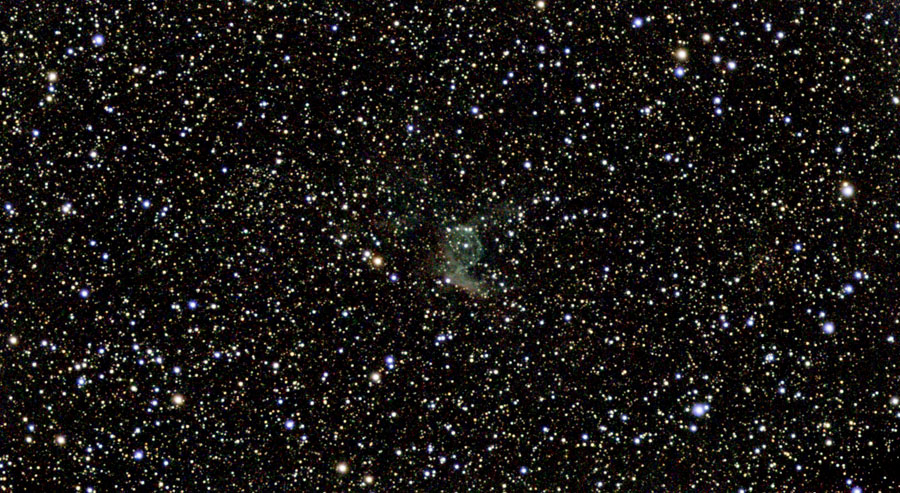 |
|
NGC 2359, Feb 13, 2023 - original, 1830s |
NGC 2359, Feb 13, 2023 - large, photo left processed |
|
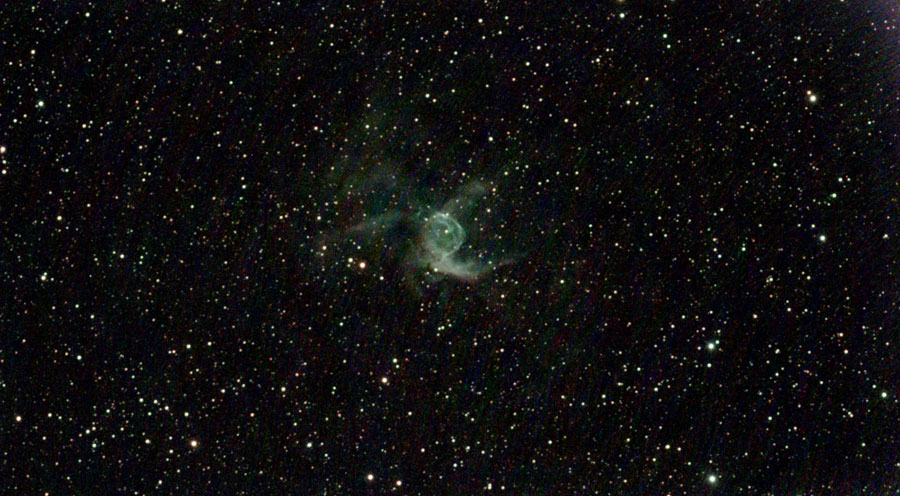 |
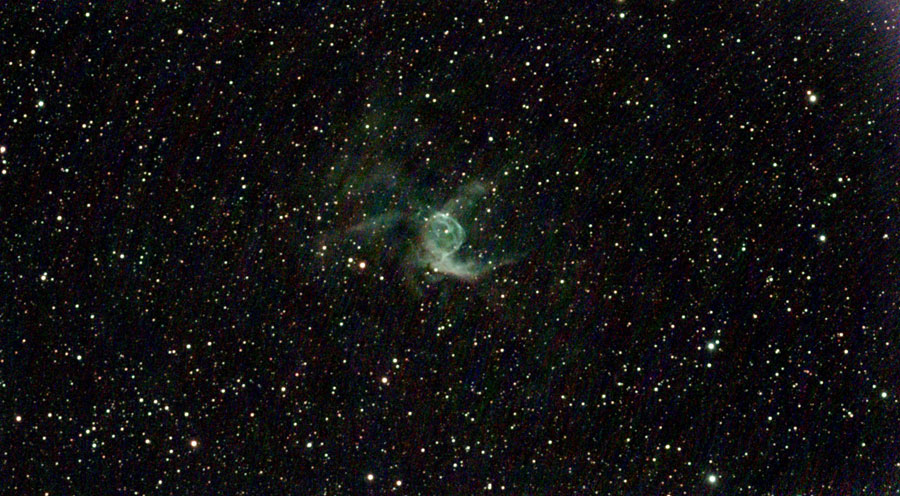 |
|
NGC 2359, Feb 20, 2023 - original, 1830s, Dual Band Filter |
NGC 2359, Feb 20, 2023 - large, photo left processed |
Here, the difference between the photos with and without the nebula filter is very clear; also the stars are strongly suppressed by the nebula filter.
IC 1805 (Heart Nebula)
 |
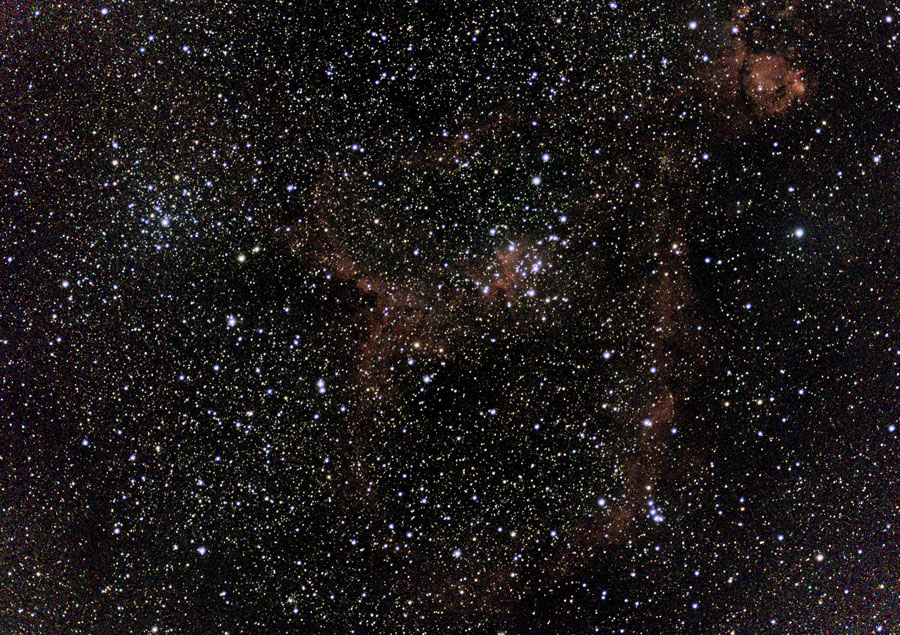 |
|
IC 1805, Nov 1, original, 3750s, mosaic |
IC 1805, Nov 1, large, photo left processed |
|
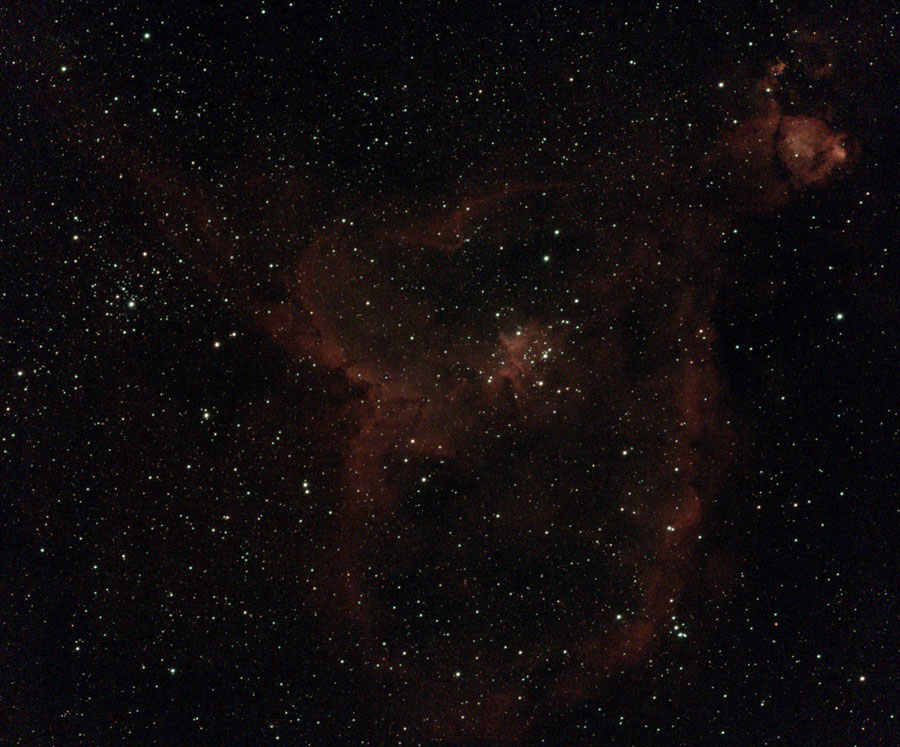 |
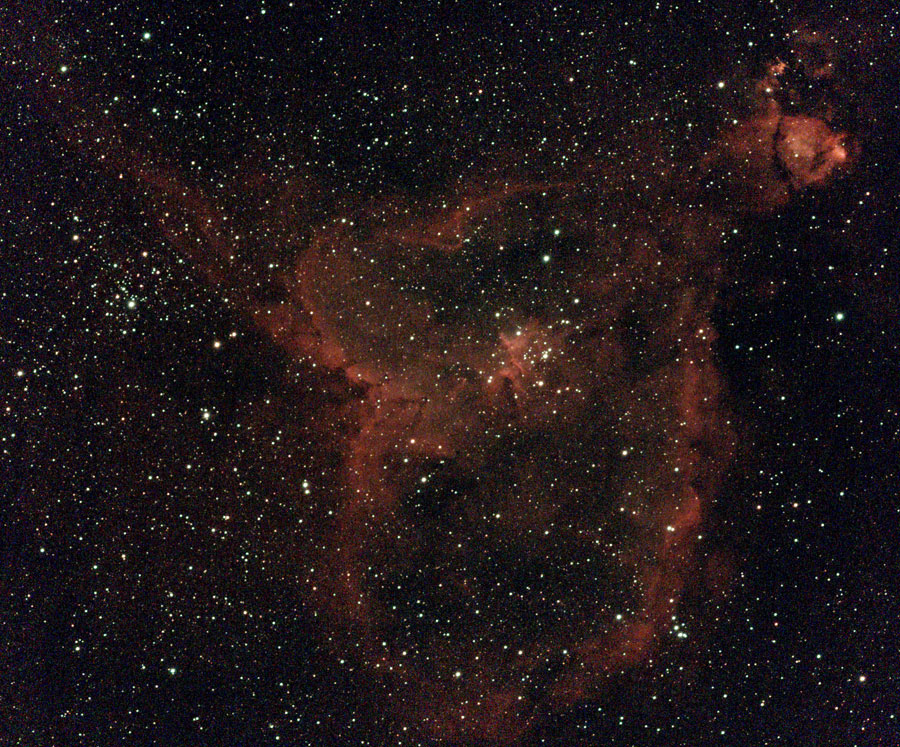 |
|
IC 1805, Feb 20, 2023 - original, 3270s, mosaic, Dual Band Filter |
IC 1805, Feb 20, 2023 - large, photo left processed |
The same applies here: the difference between the photos with and without the nebula filter is obvious; the stars are also quite strongly suppressed by the nebula filter.
NGC 2244 and Rosette Nebula (April 3, 2023)
 |
 |
|
NGC 2244 + Rosette Nebula, Apr 3, 2023 - original, mosaic, 1490s |
NGC 2244 + Rosette Nebula, Apr 3, 2023 - large, photo left processed |
|
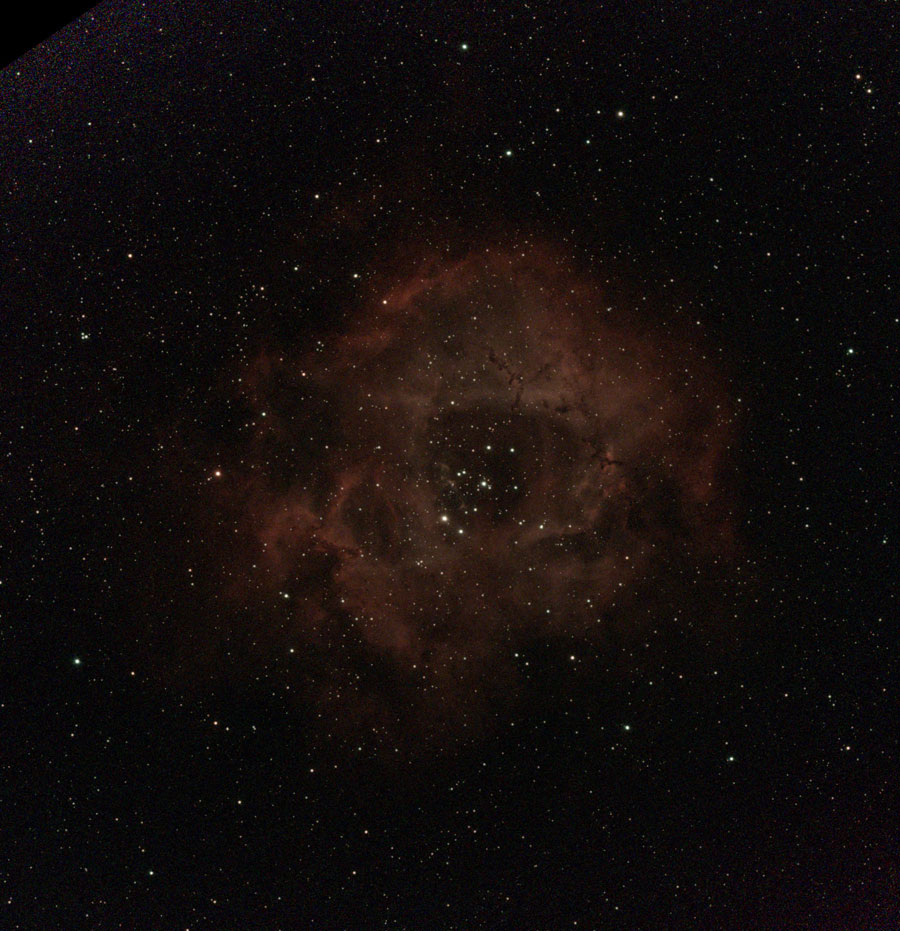 |
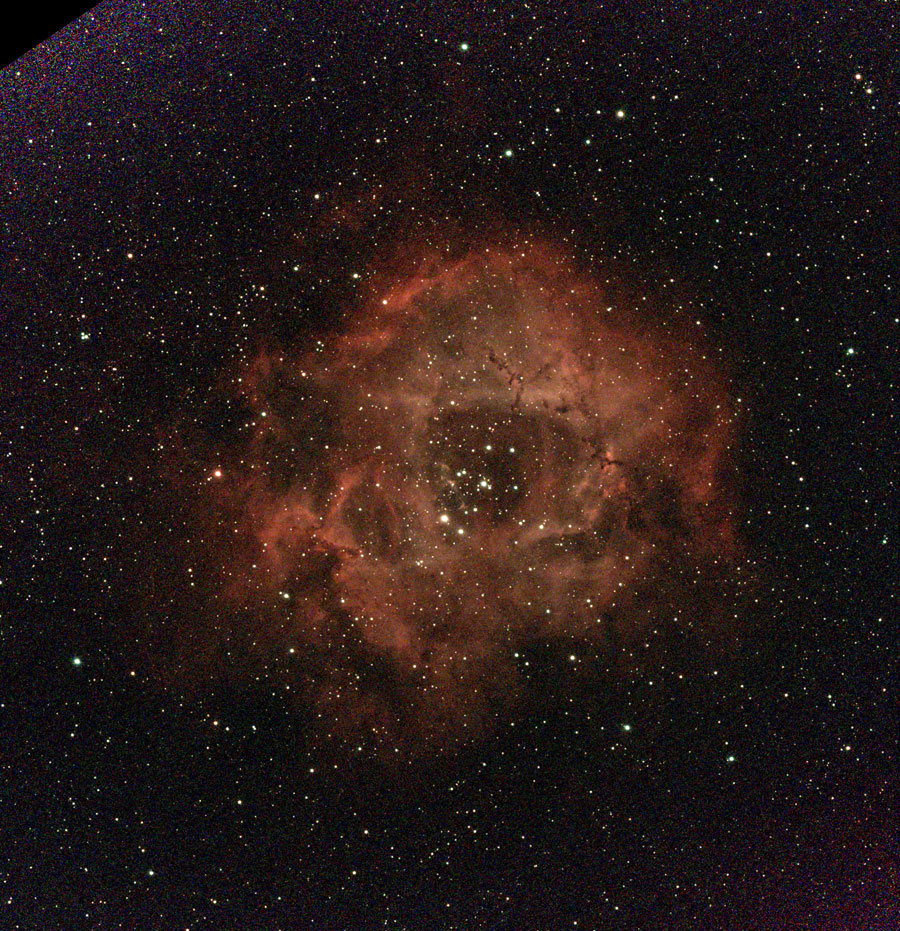 |
|
NGC 2244 + Rosette Nebula, Apr 3, 2023 - original, mosaic, Dual Band Filter, 2520s |
NGC 2244 + Rosette Nebula, Apr 3, 2023 - large, photo left processed |
Conclusion: The stars are suppressed by the Dual Band Filter and the nebula comes out much more clearly than without the filter.
NGC 2174 (Monkey Head Nebula) (April 5, 2023)
 |
 |
|
NGC 2174, Apr 5, 2023 - original, 35min |
NGC 2174, Apr 5, 2023 - large, photo left processed |
|
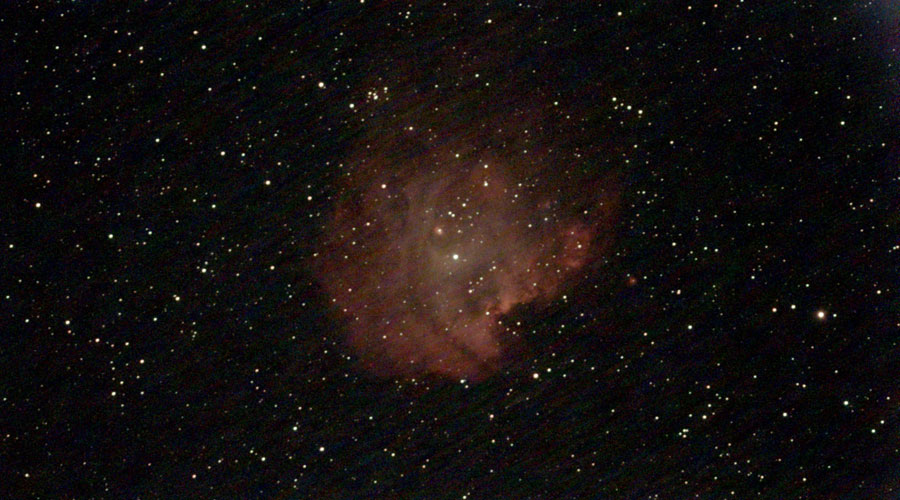 |
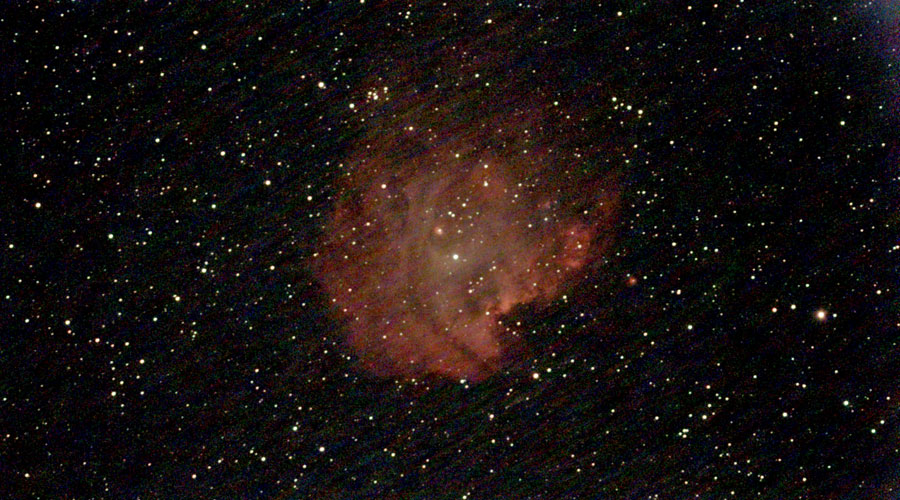 |
|
NGC 2174, Apr 5, 2023 - original, Dual Band Filter, 35min |
NGC 2174, Apr 5, 2023 - large, photo left processed |
Conclusion: The stars are suppressed by the Dual Band Filter and the nebula comes out much more clearly than without the filter. Regrettably, the photo taken with filter is heavily disturbed by noise (Walking Pattern Noise?).
Filter Comparison
NGC 2244 and Rosette Nebula (April 3, 2023)
On April 3, 2023, I tried both the CLS and the Dual Band Filter on NGC 2244 (mosaic). Here are the results (without filter first):
 |
 |
|
NGC 2244 + Rosette Nebula, Apr 3, 2023 - original, mosaic, 1490s |
NGC 2244 + Rosette Nebula, Apr 3, 2023 - large, photo left processed |
|
 |
 |
|
NGC 2244 + Rosette Nebula, Apr 3, 2023 - original, mosaic, 1850s, CLS Filter |
NGC 2244 + Rosette Nebula, Apr 3, 2023, 4.4.2023 - large, photo left processed |
|
 |
 |
|
NGC 2244 + Rosette Nebula, Apr 3, 2023 - original, mosaic, 2520s, Dual Band Filter |
NGC 2244 + Rosette Nebula, Apr 3, 2023 - large, photo left processed |
Conclusion: The Dual Band Filter suppresses the stars, which the CLS Filter does hardly or not at all. The nebula comes out more clearly with both filters than without, but much more clearly with the Dual Band Filter.
NGC 2174 (Monkey Head Nebula) (April 5, 2023)
On April 5, 2023, I tried both the CLS and the Dual Band Filter on NGC 2174 (normal photo). Here are the results (without filter first):
 |
 |
|
NGC 2174, Apr 5, 2023 - original, 35min |
NGC 2174, Apr 5, 2023 - large, photo left processed |
|
 |
 |
|
NGC 2174, Apr 5, 2023 - original, CLS Filter, 35min |
NGC 2174, Apr 5, 2023 - large, photo left processed |
|
 |
 |
|
NGC 2174, Apr 5, 2023 - original, Dual Band Filter, 35min |
NGC 2174, Apr 5, 2023 - large, photo left processed |
Conclusion: The Dual Band Filter suppresses the stars, which the CLS Filter does hardly or not at all. The nebula comes out more clearly with both filters than without, but much more clearly with the Dual Band Filter. However, the photo taken with the Dual Band Filter is also much more impacted by noise. Presumably it is Walking Pattern Noise, that is, not statistical noise, because it cannot be reduced with noise reduction software.
IC 405 and IC 410 (Apr 9 and 14, 2023)
On April 9, 2023, I tested the Dual Band Filter, and on April 14, 2023 the CLS Filter at IC 405 and IC 410 (mosaic). Here are the results:
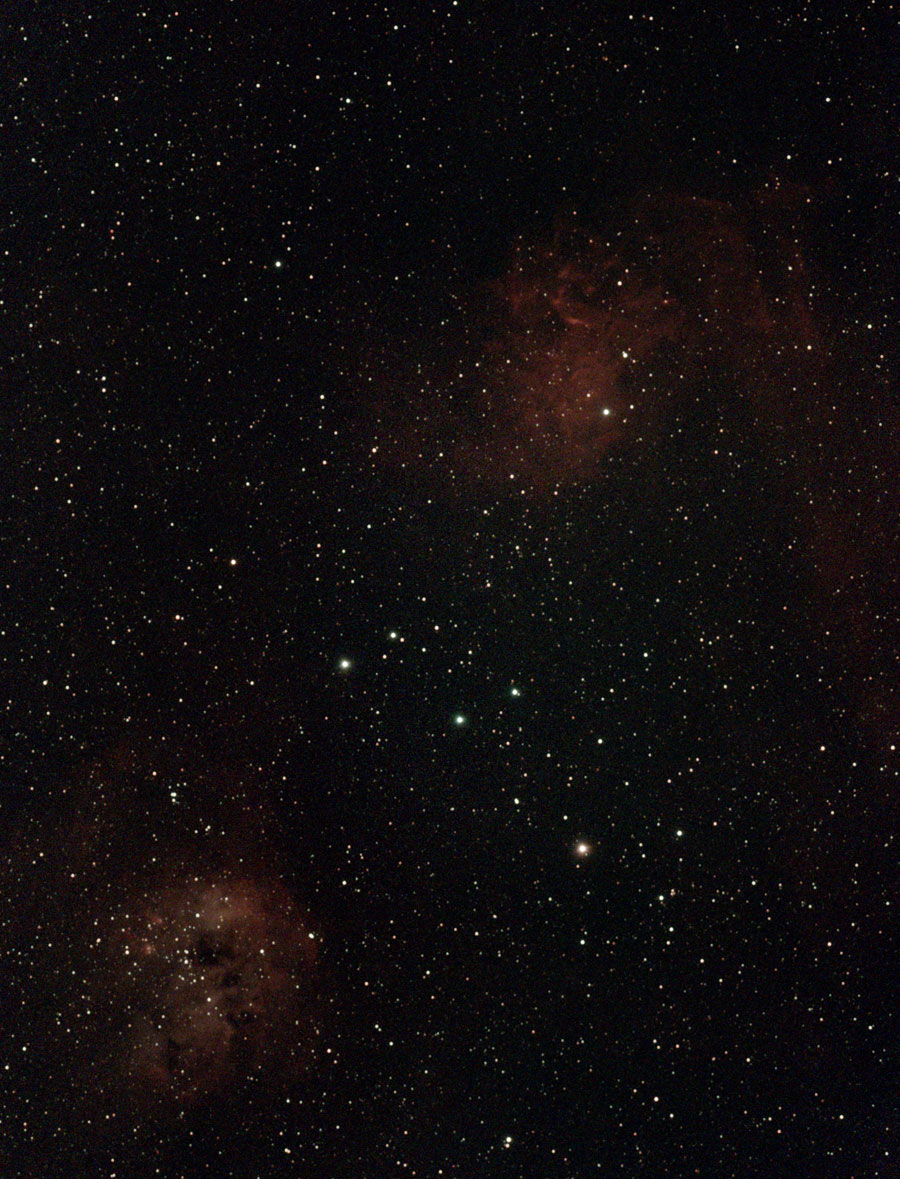 |
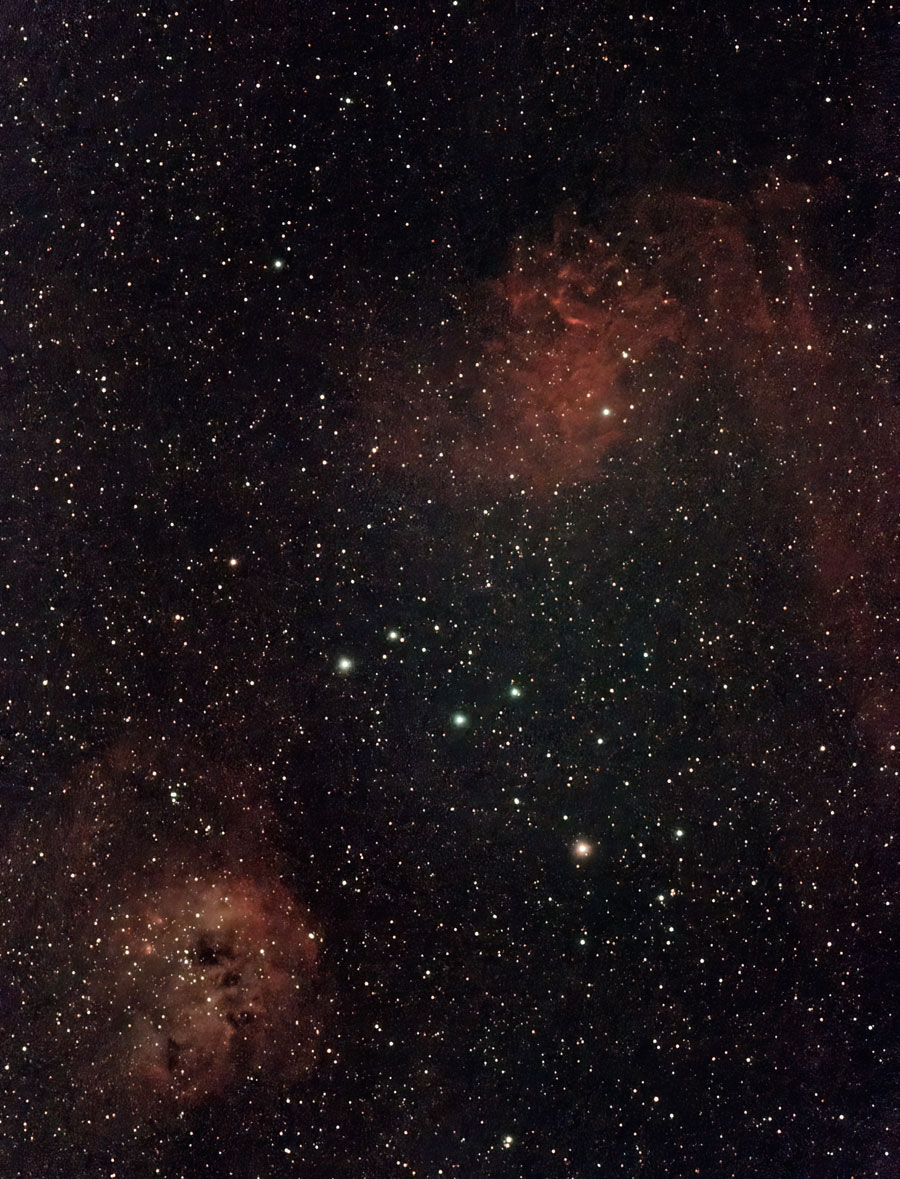 |
|
IC 405 & IC 410, April 9, 2023 - original, 3h, mosaic, Dual Band Filter |
IC 405 & IC 410, April 9, 2023 - large, photo left processed (PSE, DN) |
|
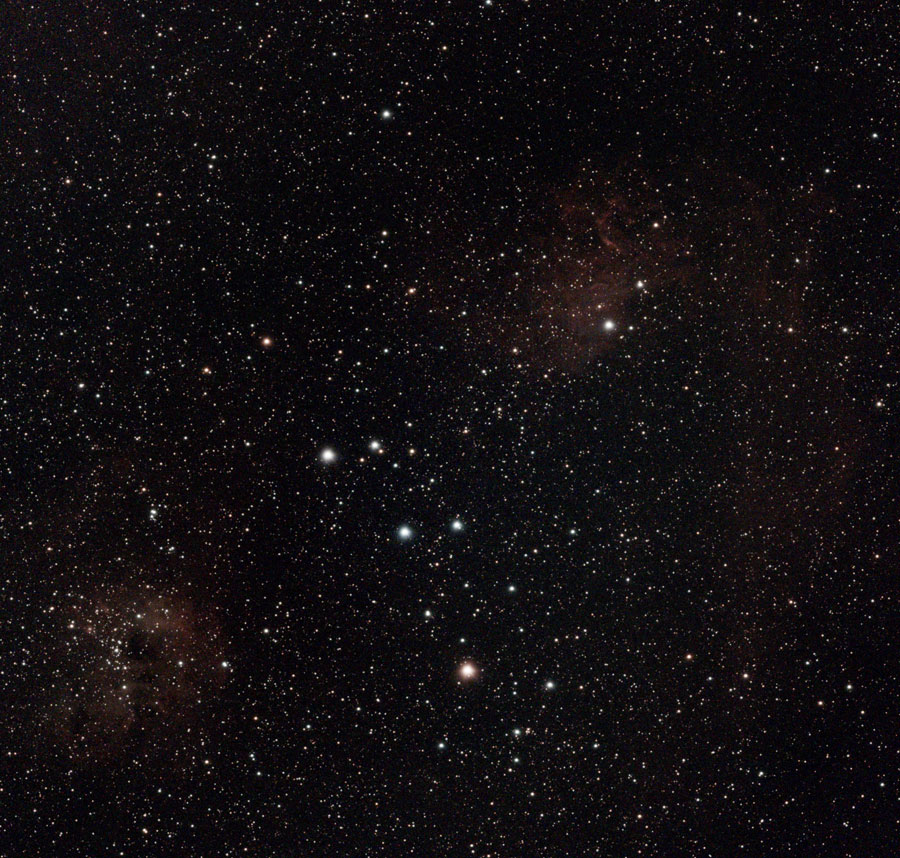 |
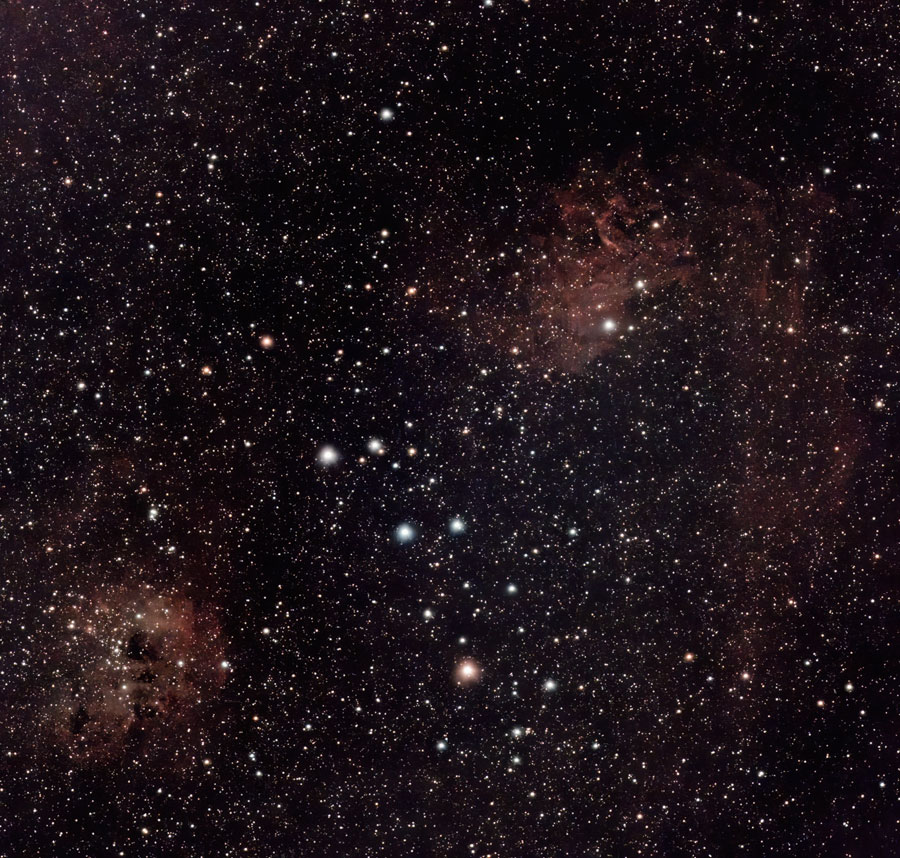 |
|
IC 405 & IC 410, April 14, 2023 - original, 1.5/2.5h, mosaic, CLS Filter |
IC 405 & IC 410, April 14, 2023 - large, photo left processed (PSE, DN) |
Conclusion: The Dual Band Filter suppresses the stars, which the CLS Filter does hardly or not at all. The nebula comes out more clearly with both filters than without one (not shown), but more clearly with the Dual Band Filter.
First Conclusions
Dual Band Filter
For all DSO, the Dual Band Filter shows a significant effect. While the effect is debatable for M 42/43 (more or less a change in color - and the loss of a dark nebula), the Dual Band Filter leads to significant quality improvenement for the other DSO. A welcome effect of the filter is also that stars are suppressed to a certain degree so that the objects in question better stand out. I find the price of 400 EUR for the Dual Band Filter high, but the improvement that I found seems to justify a purchase in my opinion. When you use the filter, you have the impression of owning a "much better" telescope...
A special effect was discovered by a star friend and also by me: photos with the Dual Band Filter can show clearly visible Walking Pattern Noise, while the respective photos without the filter do not. It turned out that this effect can only be observed with "normal" images, but not with mosaics. This is probably because mosaics use dithering (confirmed by Vaonis), which is considered the "tool of choice" for reducing or eliminating walking pattern noise. I will make appropriate comparison photos to investigate this in more detail.
Light Pollution Filter (CLS Filter)
Stars are hardly or not at all affected by the CLS filter; nebulae, however, come out more clearly than without the filter. Whether the use of this filter is generally worthwhile when the sky is not disturbed by streetlights, I cannot yet judge. Nebulae are perhaps not only shown more vividly than without the filter, but possibly also in more natural colours than with the dual band filter. In any case, more photos taken with the CLS filter are necessary to be able to judge its impact.
Note: In June 2024, I sold my Vaonis Vespera smart telescope. I therefore cannot report any further experiences with it here. |
Links
- Vaonis: vaonis.com/fr/ (FR), vaonis.com (EN)
- Vespera Light Pollution Filter: vaonis.com/product/vespera-light-pollution-filter (EN)
- Vespera Dual Band Filter: vaonis.com/product/vespera-dual-band-filter (EN)
- See also my page offering Astronomy Links.
Appendix: Light Pollution Filter and Solar Filter
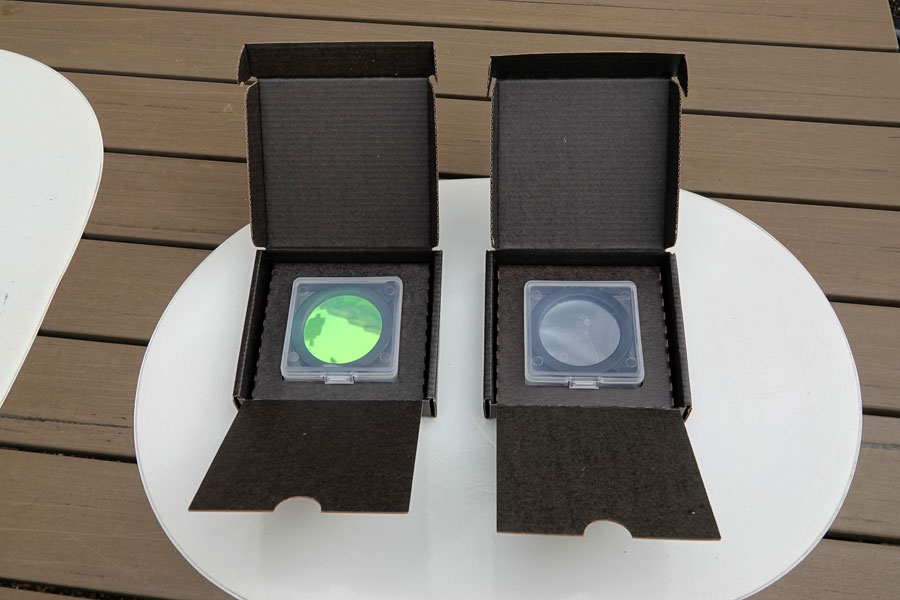 |
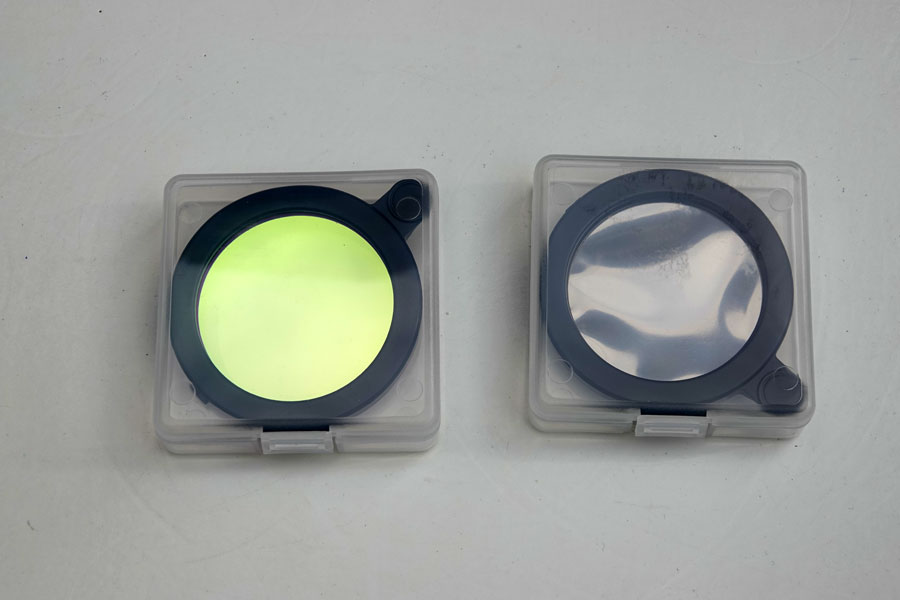 |
|||
The filters in their outer boxes |
Outer boxes opened |
The filters in their cases |
||
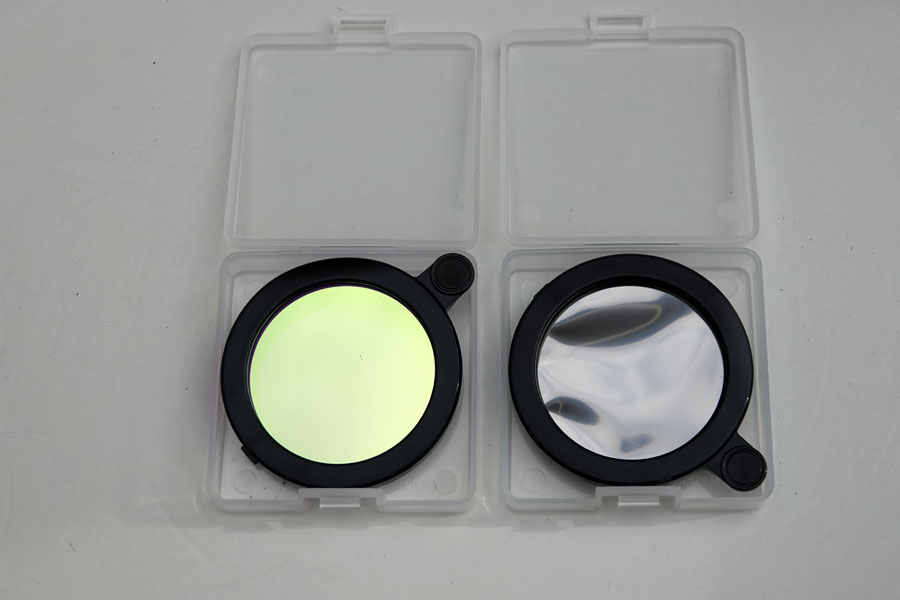 |
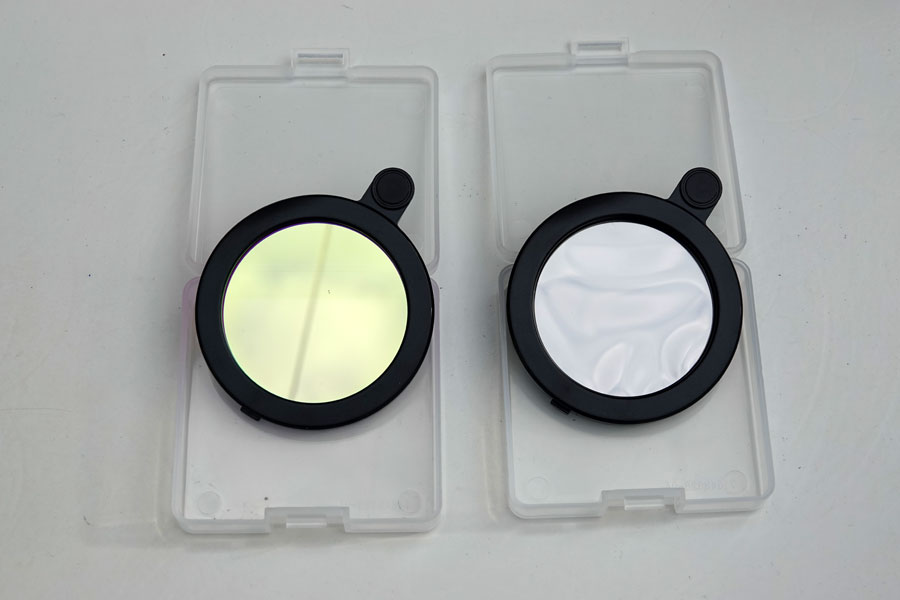 |
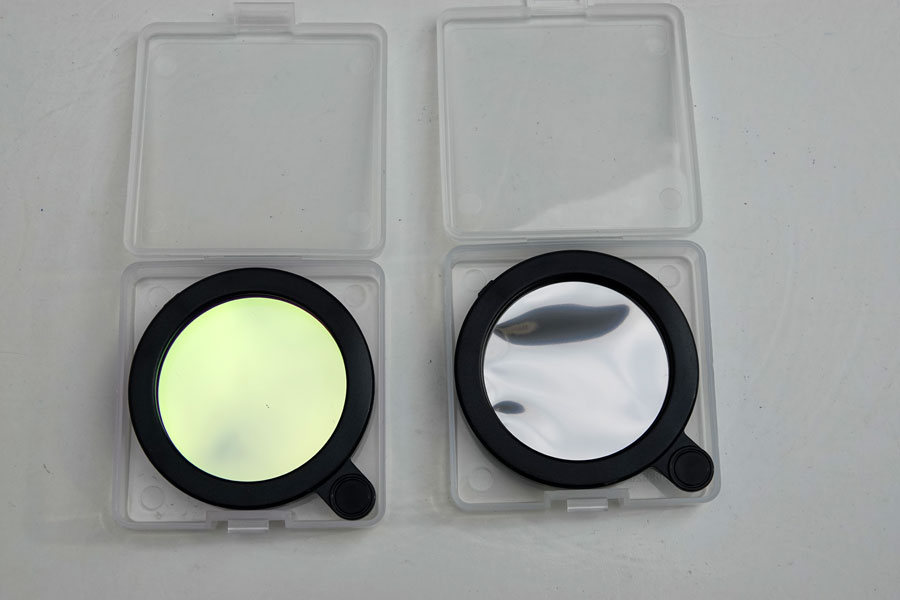 |
||
Cases opened |
Ditto |
Ditto |
Photos: Light Pollution Filter (left) and Solar Filter (right)
| 05.10.2024 |
